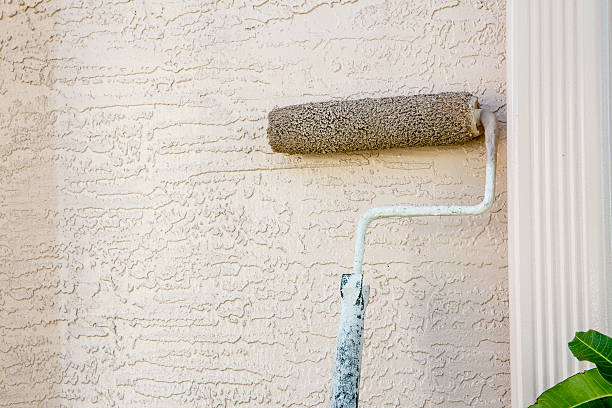How To Paint A Stucco House. Pro Tips With The Handyman Group
Date: 12 Jun 2024
If you have a stucco house, you know it's one of the most durable building materials on the market. With good maintenance and a little luck, stucco can last more than 50 years. You might find yourself wanting to paint stucco, though, and who better to talk you through it than Geoff Simmons from The Handyman Group where stucco reigns?
What Paint Is Best for Painting Stucco?
"You want to use acrylic latex paint for stucco due to its durability and flexibility, so it gets in all of the little nooks in the stucco," Geoff says. Another perk: "Acrylic paints are resistant to peeling and cracking, which is perfect for stucco."
Remember to allow for adequate drying time. For best results, pick a nice sunny stretch of mild weather. Below, Geoff gives The Handyman Group team members his time-tested pro tips and techniques for painting stucco.
Tools Required
- Extension ladder
- Paint brushes - various sizes
- Paint roller covers - 20mm to 25 mm
- Paint roller frame
- Paint tray or bucket with bucket grid
- Trowel
Materials Required
- Acrylic masonry primer (optional)
- Exterior acrylic latex paint
- Painter's tape
- Stucco patching compound
Inspect the stucco
“The first thing you want to do is inspect the stucco for any damage, or cracks,” Geoff says.
- Walk around your house and assess the stucco.
- Look for cracks, chips and flaking paint.
- Note any cracks you can fit a credit card into (about 5mm or larger). You’ll fix these before painting.
Test for alkalinity
“This is for new stucco,” Geoff says. “If the stucco isn’t fully cured, it will leach out compounds that are too alkaline, and will burn through the paint.”
- Use a pH test kit, which can be a pencil, paper strips or liquid, to check the pH. These are available at paint, pool and home improvement stores.
- Apply the strips, pencil or liquid (called phenolphthalein) to the stucco according to the instructions that came with the kit.
- Rinse with distilled water (if indicated), and watch for a color change. Usually, this will be bright pink. No color change means the stucco is fully cured.
- Stop your project if the pH is too alkaline (high). Stucco may take 30 to 60 days to cure.
Pressure wash the stucco
- Rent a pressure washer from a home improvement center, if you don’t own one.
- Add a cleaning solution that’s safe for stucco.
- Stand about 3 feet away from your house. “The distance is by feel to a degree,” Geoff says. “3 feet away is good. You can damage a substrate by being too close.”
- Pressure wash the stucco to remove dirt and impurities. “3400 psi is adequate,” he adds. “Start at the top and work your way down.”
- “Allow the stucco to dry thoroughly before painting,” Geoff says. “This may take up to a full day.”
Scrape and repair
- Use a trowel to scrape away flaking paint and loose stucco that needs repair.
- Apply textured stucco patching compound to hairline cracks. “The same goes for larger chunks that may be missing,” Geoff says. “Follow the instructions on the patching kit.”
- Wipe excess patching compound off the stucco. Use a damp paintbrush to dab and feather the edges if needed, so they won’t be visible after painting.
- Allow the compound to cure according to the instructions before moving forward.
Apply primer, if needed
- Prime new stucco before painting. Fresh stucco soaks up a lot of paint.
- Choose an acrylic primer that is appropriate for masonry applications.
- Use a heavy nap roller, 3/4 inch to 1 inch.
- Work from top to bottom, then side to side, to get full coverage.
- Allow to dry according to primer instructions before painting.
Apply paint
- Cut in around windows and doors with a small roller or paintbrush.
- Use painter’s tape to get a clean line, if helpful.
- Apply acrylic latex paint. “Use a heavy nap roller, 3/4 inch to 1 inch, to paint stucco, so you get inside all the nooks and crannies,” Geoff says.
- Start by painting top to bottom, then go from side to side. “Apply the paint in multiple directions to get in all the areas of the stucco,” Geoff says.
- Work in small sections so you maintain a wet edge.
- Apply a second coat on rougher stucco, if needed, or use a paint sprayer.
Maintain the stucco
- Inspect your stucco once a year to check for cracks.
- Direct sprinklers away from stucco to avoid water staining or intrusion.
- Clean stucco once a year, or as needed, with a garden hose or low-pressure washing.

